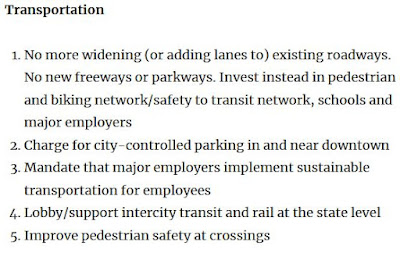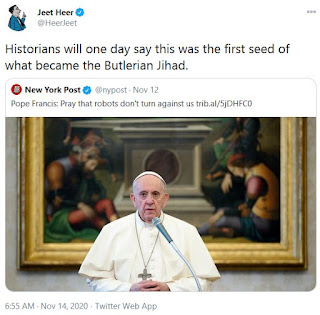The technical committee for the MPO meets tomorrow, Tuesday the 9th, and they will be thinking about new funding and new projects.
 |
| Fire and Ice Oregonian, Nov. 1st and today |
 |
| LA Times, today |
In the minutes from last month's meeting on starting a framework for scoring project applications in the 2024-2029 cycle, MPO staff underscored that "The MPO has a broader focus than the Climate Friendly rulemaking," listing it as only one complication and priority among several. While that is strictly true in a trivial sense, it was also meant as a way to continue to slow-walk on climate, to disparage and minimize the urgency of action action now.
 |
| Slow-walking "climate friendly rulemaking" |
At this month's meeting of the Technical Advisory Committee, they return to considering how to score and prioritize applications for that 2024-2029 cycle and also how to score and prioritize projects for new funding in the new Federal Infrastructure bill. (When the agenda was written, it was possibility, but now it is reality.)
 |
| Agenda items on scoring and prioritizing |
Something in that Infrastructure bill to watch for are moves or incipient tendencies to define, codify, and penalize "improper walking" and to add new surveillance technologies to control walking.
 |
| via Twitter |
 |
| via Twitter |
This is a dystopian element in our current mania for robot cars, which as they struggle to be safer than human driving seek to off-load responsibility for safety to other road users by increased control mechanisms and to gain indemnity for themselves. (See previously "Robot Cars Should not Tempt us to Try to Criminalize Improper Walking." And more below in a footnote on robot cars likely increasing total VMT.*)
So, back to the MPO. In the list of possible uses for new Federal funds, there were some interesting notes. It turns out that the sidewalk between Vista and Ratcliff on south Commercial is not yet fully funded, and needs almost $3 million for construction.
 |
| Current projects in need of funding. |
Other project ideas include ones previously funded, which which now need completion funding:
- The McGilchrist redesign project between 12th and 25th
- Sidewalks and pavement on Orchard Heights at the Park and up the hill
- State Street redesign between 13th and 17th
- Sidewalk on Commercial between Ratcliff and Vista
- State Street redesign east of Lancaster Drive
- Center Street redesign east of Lancaster Drive
- Intersection "improvements" on Broadway at Hood (probably will have the same problems as we encountered on the Broadway at Pine project)
Other projects are either wholly new or have sought and failed to gain funding previously:
- Fisher Road redesign between Silverton Road and Sunnyview
- Brush College Road sidewalk at school
- Sidewalks on Pringle Road south of Hoyt Street
- Pringle Creek Path between Mirror Pond and Riverfront Park
- Second Street crossing under Wallace Road to Wallace Park and Union Street Bridge
- Cordon Road interchange with Highway 22, and also Cordon Road redesign
- I-5 Chemawa Interchange
- I-5 Brooks Interchange
- I-5 widening south of Keubler
- Mission Street/OR-22 widening between 25th and Hawthorne
There are several highway projects in that second list, and we have to ask whether our needs on climate can tolerate any additions to highway capacity with widening.
 |
| "No more widening" leads the list from our 350.org |
The Technical Advisory Committee zooms on Tuesday the 9th at 1:30pm. The agenda and packet can be downloaded here.
 |
| Meeting info |
* Footnote on Robot Cars and VMT
Even in the face of robot cars failing to recognize people on foot or on bike and killing them, people are enthusiastic about the tech-utopianism. But if they seem to offer convenience, reduced parking requirements, and at least the theoretical possibility of improved safety, the cars still consume the same amount of space as a regular car.
 |
| updated via jonorcutt (see below for original) |
While a robot car may not need a parking spot for the car at rest, when they are not ferrying passengers, they will still be driving around in so-called "deadhead" miles. Robot cars shift the problem of parking to intensify the problem of deadheading.
Deadhead miles contribute to congestion.
 |
| (The original is from Muenster, Germany has become a meme of its own - here's a history of it) |
And increasing research suggests the deadhead miles will actually add to congestion and to total driving, measured in vehicle miles traveled. These notes are not an exhaustive review of the literature, but without researching too long, several papers from this year floated quickly to the surface.
 |
| Transport Policy, March 2021 |
From Transport Policy (whole paper also here):
These large VMT increases are driven by the addition of dead-head miles before each pick-up and the absence of offsetting VMT reductions among travelers who switch to ride-hail from public transportation, biking and walking. VMT increases are only modestly mitigated by the use of ride-hail for “first mile/last mile” trips to connect to public transportation or by reduced cruising for parking by drivers in their personal vehicles.
In sum, ride-hail adds to vehicle mileage for trips associated with ride-hail even taking into account pooling. This pattern is likely to endure in a world of autonomous vehicles given that auto users tend to switch to solo services due to considerations of travel time, reliability, comfort and privacy, while pooled options mainly draw patrons from sustainable modes like public transportation. The implication for public policy is that in dense urban areas, it remains important for policy-makers to prioritize space-efficient modes of public transportation, walking and biking.
 |
| TRB paper, last January |
A separate paper presented in January at the Transportation Research Board meeting concluded "automated vehicles, even when deployed in a shared autonomous fleet, will likely bring an increase of VMT (up to 36%) due to mode shifts and deadheading."
 |
| Todd Littman at Victoria Policy Institute |
And in a little more of a review of the literature, in a new paper from September Todd Littman concluded "with current policies, vehicle travel and sprawl are likely to increase 10-30% [with autonomous vehicles]."
If we want to reduce driving, robot cars are not any obvious answer, and will likely make things worse.
 |
| via Twitter |
And with Dune and Frank Herbert's brief connection to Salem in the news recently, it's worth thinking about privacy in surveillance capitalism and industry and about threats from artificial intelligence.
 |
| Joking, but not joking - via Twitter |


No comments:
Post a Comment